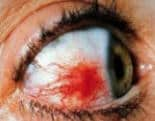Autoimmune risk females
women and autoimmunity risk
Women at greater risk for autoimmune diseases with ocular manifestations episcleritis
episcleritis
Communication with physicians managing the patient's systemic disease is crucial.
Women are as much as 50 times more likely to suffer from certain autoimmune diseases than men, and these diseases often have ocular manifestations that ophthalmologists should be aware of when examining their female patients, experts say.
"Autoimmune diseases are the No. 1 example of the higher risk" women carry for certain diseases due to sex, said Janine A. Smith, MD, of the National Eye Institute. "There are a lot of autoimmune diseases, and nearly every single one affects women more than men."
Stress in life and from pregnancy and monthly periods are know issues.
SJogren's syndrome, with its symptoms of dry eye and dry mouth, is a prime example of an autoimmune disease seen more often in women. In addition, she said, systemic lupus erythematosus, rheumatoid arthritis and thyroid disease all disproportionately affect women, and all can have ophthalmic manifestations.
>
One theory, is that because estrogens are naturally proinflammatory and androgens, specifically testosterone, are considered anti-inflammatory, women are more prone to developing autoimmune problems.
Lupus
Systemic lupus erythematosus, a collagen vascular disease, affects women nine times as often as men. Typically young, middle-aged women are affected, said C. Stephen Foster, MD.
Lupus often causes dry eye, for which treatment is much like that for Sjogren's syndrome, but there are other possible ocular complications as well.
"It might be something as relatively trivial as a rash, a low grade subtle dermatitis on the lid, or something that is directly relating to the eyeball itself with episodes of superficial inflammation," he said. "This superficial inflammation may be affecting only the conjunctiva or, more prominently, it will be episodic inflammation of the tissues deeper to the conjunctiva like the episclera or sclera."
Recurring episcleritis is a "trivial" but common ocular complication of lupus, Dr. Foster said. While it rarely requires aggressive therapy, episodes are often treated with corticosteroid drops, which can have long-term consequences, he explained.
"Eventually there is a price to pay, most particularly with respect to development to cataract," he said. "We believe taking an oral nonsteroidal anti-inflammatory medication is the most productive and appropriate way to address that."
Keratitis is another ocular manifestation of lupus. Patients can develop peripheral keratitis or multifocal superficial corneal inflammation, leaving small nebulae in the superficial cornea stroma.
"Both of them are associated with light sensitivity and photophobia. Both are important because they both carry with them a little more prognostic significance than does episcleritis or conjunctivitis," Dr. Foster explained. "Both are fairly disabling because of the photophobia."
He said, again, corticosteroids are usually used for treatment, but the long-term solution for keratitis is to address the underlying lupus with systemic medication.
The systemic manifestations of lupus make it a potentially life threatening disorder, said Kathryn Colby, MD, PhD.
"The treatment is first identification of the systemic disease associated with it," she said. "Often, management of the systemic disease will help with the ocular manifestations."
Unfortunately, Drs. Colby and Foster said, Plaquenil (hydroxychloroquine, Sanofi Winthrop), the traditional systemic treatment for lupus, can cause damage to the retina when used in high dosage.
- Dematomyositis
- Trigger factors fibromyalgia
- back surgery.
- Neck pain
- Facet Joints pain
- Injuries
- Injuries
- Pain in body
- Common pain
- back pain
- D for pain
- avoid osteoporosis
- CIDP-family issue
- FMS CFS
- Symptoms FMS
- Cardiomyopathy
- Peripheral Neuropathy
- ALS & CIDP
- Types of neuropathy
- Altitude neuropathy
- help for heart
- safe hair color
- help for Diabetics
- skip mammogram
- help for prostate
- help for vitamins
- help for toxicity
🌞